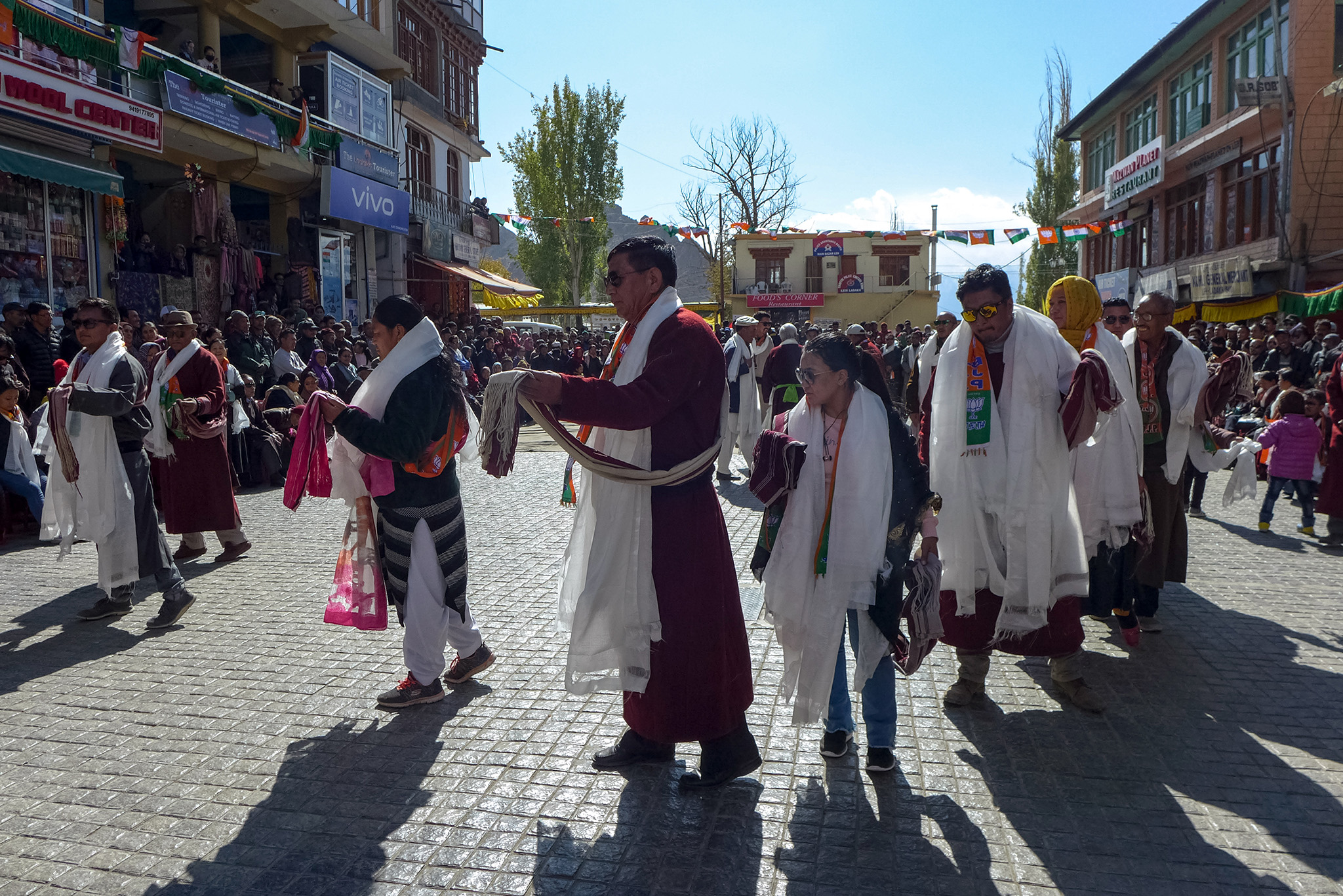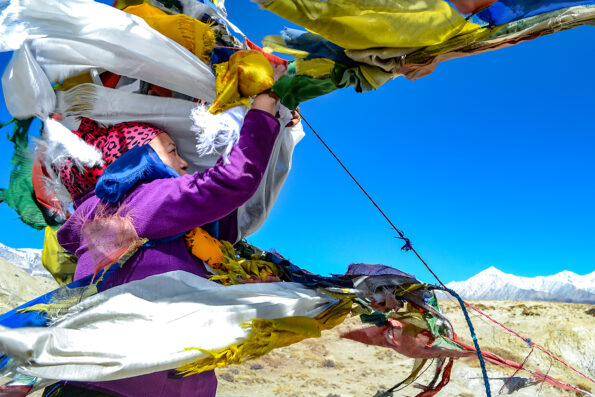
Raihana Maqbool, GPJ Indian-administered Kashmir
Residents in Indian-administered Kashmir celebrate the establishment of the Union territory of Ladakh. The Indian government revoked the semi-autonomous status of Jammu and Kashmir last August and carved it into two union territories, sparking mixed reactions.
LEH, INDIAN-ADMINISTERED KASHMIR — They danced in the marketplace with the mountains as their backdrop, whirling through a traditional song and applauding the change that had just come to this disputed land.
A small crowd cheered and waved the saffron, white and green colors of India’s flag as they commemorated Prime Minister Narendra Modi’s decision last August to create a new status for their region.
The government had just revoked an article in the Indian Constitution that granted semi-autonomy to the state of Jammu and Kashmir and instead carved the region into two union territories: Jammu and Kashmir, a largely Muslim area that includes the lush Kashmir Valley, and Ladakh, a mountainous, historically Buddhist expanse that sits to the east and borders China.
Revelers from Leh, one of two districts in the Union territory of Ladakh, were banking on a boom in tourism and infrastructure development as Modi sought to better integrate the region into India. But the celebration carried an undercurrent of unease – one that has fractured the two districts and sowed a broader fear of cultural sabotage, even a year after the announcement. The previous status allowed the region to make its own rules for who could live there and purchase property, and Ladakh residents now worry that outsiders will buy up this scenic land, jeopardize the region’s fragile, pristine climate and destroy its distinctiveness.
“Our identity is at risk,” says Tsering Tondup, 72, a retired forest department employee in Leh, once an important link on the Silk Road trading route and a popular starting point for trekking.



Residents grew more concerned about an invasion of outsiders after videos appeared on social media featuring Indian men who suggested coming to the region in search of beautiful Kashmiri brides.
Modi tried to tamp down fears in an independence speech last August, when he argued that the semi-autonomous system had “aggravated separatism and given birth to terrorism.” He said people in the region would now “get the rights which they have been deprived of so far.”
The decision proved the latest change to a region countries have fought over for more than seven decades. When Pakistan and India separated in 1947, the princely state of Jammu and Kashmir, as it was known then, landed in the middle of the tug-of-war. Both countries claimed pieces of the region and, along with China, still do. That tension heightened in June, when Indian and Chinese soldiers with clubs and rocks reportedly clashed at the border, killing 20 Indian troops and leading to the region’s worst violence in nearly a half-century.
The creation of these territories has thrown more uncertainty into the contested region, dividing Ladakh’s two districts, Leh and Kargil.
Fears about cultural loss pervade both. But many residents in Leh, whose Buddhist monasteries are scattered among the Himalayan mountains, backed the union territory status because they thought support from India would improve the region’s economic prospects.
“The only fear is that the fragile ecology may be lost,” says Phunsuk Dolma, a Leh schoolteacher. “But this decision is good for Leh, as we never got development that should have been here.”
Those in Kargil, a rural, largely Muslim community closer to the Muslim-majority Kashmir Valley, see it less as an economic opportunity than as a political silencing.
The semi-autonomous status allowed the former state its own constitution, a separate flag and the freedom to make laws on everything except foreign affairs, defense and communications.
The new plan grants the Union territory of Jammu and Kashmir its own legislative assembly; Ladakh does not have one. It instead defers to the Indian central government. This has infuriated some Kargil residents, who believe their political rights are eroding along with their business and cultural ties.
“Ladakh had a communal harmony for ages and dividing it from Jammu and Kashmir will only create problems,” says Nazir Munshi, a hotel owner and member of the Joint Action Committee, a group of think tanks and other organizations trying to protect the interests of Kargil. “Since accession, we have had business, political and religious relations with Kashmir. These relations were divided within a night.”



Soon after the change, India shut down internet access in Jammu and Kashmir for months. The coronavirus pandemic has added another layer of fear, as the entire region shuttered and patrolling soldiers filled the streets.
“We are left nowhere,” says Zakir Ali, a driver and Kargil resident, who says they were not consulted about the union territory decision.
Ladakh officials could not be reached for comment, and the Indian central government did not respond to requests for comment. A provision in the constitution allows districts or regional councils to administer tribal areas, a move intended to preserve an area’s culture and ecology. The Indian government has said it will grant a special cultural distinctiveness status to Ladakh but has not specified what that will entail.
With little guidance, residents across the district wonder what to prepare for next.
“Outsiders will come and live here, and it will not be safe for the girls,” says Ambreen Fatima, a 17-year-old student, referring to social media comments about snagging Kashmiri brides. “It was not a good decision.”







